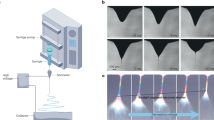Abstract
Informed by the numerous theoretical and practical discoveries arising from scientific literature on electrospinning over the last twenty years, coupled with the authors’ considerable industry experience in the field, this chapter examines the realities of engineering reproducible and robust electrospinning manufacturing systems. The development of such systems is discussed around the framework of robust process design, and focuses on the parameters critical to translation of small-scale laboratory-based electrospinning constructs to medium or large-scale production lines. The benefits of well-defined product design specifications, appreciation of desired manufacturing scale, equipment selection, process control and finally quality management systems and regulatory concerns are discussed in such a way that is accessible to those with backgrounds in either laboratory-scale electrospinning or process engineering for medical devices. The viewpoint examined herein remains relatively under-investigated in the electrospinning field, however as the technique continues to mature from a research-based to a true manufacturing technique the challenges addressed below are anticipated to become increasingly important.
Access this chapter
Tax calculation will be finalised at checkout
Purchases are for personal use only
Similar content being viewed by others
References
Ahmed FE, Lalia BS, Hashaikeh R (2015) A review on electrospinning for membrane fabrication: challenges and applications. Desalination 356:15–30. https://doi.org/10.1016/j.desal.2014.09.033
Hayes TR, Hosie IC (2015) Turning nanofibres into products: electrospinning from a manufacturer’s perspective. In: Electrospinning for high performance sensors. Springer, Berlin, pp 305–329
Dai Y, Liu W, Formo E et al (2011) Ceramic nanofibers fabricated by electrospinning and their applications in catalysis, environmental science, and energy technology. Polym Adv Technol 22:326–338
Haider A, Haider S, Kang IK (2015) A comprehensive review summarizing the effect of electrospinning parameters and potential applications of nanofibers in biomedical and biotechnology. Arab J Chem. doi: https://doi.org/10.1016/j.arabjc.2015.11.015
Khorshidi S, Solouk A, Mirzadeh H et al (2015) A review of key challenges of electrospun scaffolds for tissue-engineering applications. J Tissue Eng Regen Med 10:715–738. https://doi.org/10.1002/term.1978
Miao J, Miyauchi M, Simmons TJ et al (2010) Electrospinning of nanomaterials and applications in electronic components and devices. J Nanosci Nanotechnol 10:5507–5519. https://doi.org/10.1166/jnn.2010.3073
Pillay V, Dott C, Choonara YE et al (2013) A review of the effect of processing variables on the fabrication of electrospun nanofibers for drug delivery applications. J Nanomater 789289:22
Wu H, Pan W, Lin D, Li H (2012) Electrospinning of ceramic nanofibers: fabrication, assembly and applications. J Adv Ceram 1:2–23
Persano L, Camposeo A, Tekmen C, Pisignano D (2013) Industrial upscaling of electrospinning and applications of polymer nanofibers: a review. Macromol Mater Eng 298:504–520
Electrospintech (2016) Electrospun applied products. http://electrospintech.com/products.html. Accessed 16 Dec 2016
Abrahamsson P, Warsta J, Siponen MT, Ronkainen J (2003) New directions on agile methods: {A} comparative analysis. 25th Int Conf Softw Eng Proc, pp 244–254. doi: https://doi.org/10.1109/ICSE.2003.1201204
Bozdogan K (2010) Towards an integration of the lean enterprise system, total quality management, six sigma and related enterprise ESD-WP-2010-05 ESD working paper series towards an integration of the lean enterprise system, ESD-WP-2010-05. ESD Work Pap Ser 5:1–23
Cagnazzo L, Taticchi P (2009) Six sigma: a literature review analysis. In: Bulucea CA, Mladenov V, Pop E et al (eds) Recent advances in e-activities, information security and privacy. Puerto De La Cruz, pp 29–35
FDA (2016) Code of federal regulations. In: 21 C.F.R. 21. US Government, p § 820
ISO 13485:2003(E) (2003) Medical devices – quality management systems – requirements for regulatory purposes. ISO 134852003(E)
Chen R, Morsi Y, Patel S et al (2009) A novel approach via combination of electrospinning and FDM for tri-leaflet heart valve scaffold fabrication. Front Mater Sci China 3:359–366. https://doi.org/10.1007/s11706-009-0067-3
Leach MK, Feng Z-Q, Tuck SJ, Corey JM (2011) Electrospinning fundamentals: optimizing solution and apparatus parameters. J Vis Exp:1–5. https://doi.org/10.3791/2494
De Vrieze S, Van Camp T, Nelvig A et al (2009) The effect of temperature and humidity on electrospinning. J Mater Sci 44:1357–1362. https://doi.org/10.1007/s10853-008-3010-6
Nezarati RM, Eifert MB, Cosgriff-Hernandez E (2013) Effects of humidity and solution viscosity on electrospun fiber morphology. Tissue Eng Part C Methods 19:810–819. https://doi.org/10.1089/ten.TEC.2012.0671
Pelipenko J, Kristl J, Janković B et al (2013) The impact of relative humidity during electrospinning on the morphology and mechanical properties of nanofibers. Int J Pharm 456:125–134
FDA (2016) Technical considerations for additive manufactured devices draft guidance for industry and food and drug administration staff. US Government
Author information
Authors and Affiliations
Corresponding author
Editor information
Editors and Affiliations
Rights and permissions
Copyright information
© 2017 Springer International Publishing AG
About this chapter
Cite this chapter
Burke, L.D., Blackwood, K.A., Zomer Volpato, F. (2017). Reproducibility and Robustness in Electrospinning with a View to Medical Device Manufacturing. In: Almodovar, J. (eds) Electrospun Biomaterials and Related Technologies. Springer, Cham. https://doi.org/10.1007/978-3-319-70049-6_1
Download citation
DOI: https://doi.org/10.1007/978-3-319-70049-6_1
Published:
Publisher Name: Springer, Cham
Print ISBN: 978-3-319-70048-9
Online ISBN: 978-3-319-70049-6
eBook Packages: Biomedical and Life SciencesBiomedical and Life Sciences (R0)




